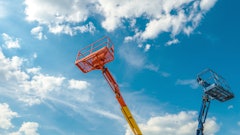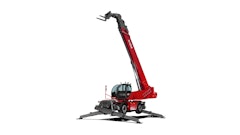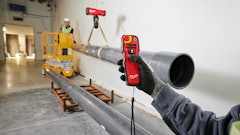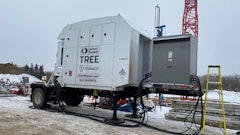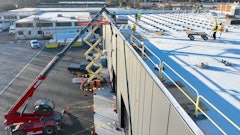
From 2012 to 2022, there were 130 fatalities, 42 major injuries and 11 minor injuries due to accidents when using mobile elevating work platforms (MEWPs,) according to the International Powered Access Federation (IPAF). The 236 reports came from 20 countries. Since the International Powered Access Federation (IPAF) began analyzing accident data in 2012, falls from platforms have been the most common cause of injury and death when using mobile elevating work platforms.
Involved in falls from the platform include static boom (1b) type machines (30.8 percent of incidents), mobile vertical (3a) types (28.8 percent) and mobile booms (3b) (22.8 percent). Because any accident relating to MEWPs is one too many, this information calls to question whether the industry will ever eradicate falls from MEWPs. Can the industry focus on this single issue, place the necessary resources and erase this potential hazard to result in zero fatal accidents? Scott Owyen, director of training at Genie; Tony Groat, regional manager at IPAF; Paul Baillargeon, owner of Aerial Lift Safety Solutions; Mark Hinkle, president of Hinkle Equipment Rental; and Ebbe Christensen, IPAF NA council chair and president and CEO at Ruthmann Reachmaster North America, LP dig into this question and more.
The Problem
There are essentially three ways in which an individual can fall from a MEWP, according to Owyen:
1. Exiting the platform at height without following the proper guidance from the manufacturer or failing to wear the proper personal fall protection equipment.
To prevent this, manufacturers will provide guidance on how to safely exit a MEWP at height, and that guidance must be followed to the letter. Note that guidance for exiting a scissor lift will be different than that for a boom, and it is critical to follow the correct guidance for the MEWP being used.
2. Standing on the guardrails.
This is typically the result of using the wrong machine for the application and should never be done under any circumstance. Similarly, placing planks on the mid or top rails or homemade steps or ladders in the platform creates the same hazardous conditions.
3. Being ejected or catapulted from the platform.
This can be caused by driving the machine too quickly and running over an obstacle, driving the machine over a void in the ground or on a surface that cannot sustain the weight of the MEWP, the platform becoming entangled with a structure or the operator trying to release it by driving away from the obstacle or by being struck by an object or vehicle.
Other root causes of accidents involving MEWPs can include:
- Lack of an effective MEWP safe-use plan by users and employers
- Inadequate operator training
- Inadequate supervision
- Improper MEWP selection
- Lack of concern over the risk
- Inconsistent requirement for personal fall protection equipment (PFPE)
- Lack of an engineered solution to have the operator connected to a MEWP operator anchorage prior to MEWP movement
“Much like with car accidents, the challenge is that multiple factors are at play at the same time: location, ground conditions, weather work type, equipment type, equipment condition, operator skills and competence, training and site management,” Christensen says. “A more detailed review of the falls (through a risk assessment) is needed to reveal more details about the core reason for the fall."
PFPE
Many falls involve the operator not wearing the PFPE—or even knowing whether or not it’s required.
“The issue of whether personal fall protection equipment should be required on scissor lifts has been, and still is, a constant source of confusion,” Owyen says. “There still seems to be no standard approach to making that determination, and the thought processes, standards and manufacturer recommendations are all over the board. Over the years, there have been very few, if any, changes in the standards regarding the use of fall protection equipment on MEWPs.”
Per ANSI A92.22-2021 and CSA B354.7-17 standards, the guardrail system of the MEWP is the primary fall protection for occupants. When required to use personal fall protection, either fall restraint or fall arrest, operators and occupants shall comply with the instructions provided by the manufacturer regarding anchorage(s).
Standards for Type 1, Group A (1a) manually propelled elevating work platforms and Type 3, Group A (3a) self-propelled elevating work platforms, such as scissor lifts and single personnel lifts, do not require the use of PFPE in addition to guardrails.
“If PFPE was universally required, it would eliminate any user or operator confusion on when it is required,” Groat says. “It would add another layer of protection. It is a requirement in Canada, and falls from MEWPs are not widely seen.”
Hinkle notes that the standards in place seem to be intended for users of MEWPS who are either decently informed or under the supervision of managers that have some respect for the risks and thus provide PPE and instruction in its use.
“I do not see that there is confusion (on standards) when it is my belief that the people that are not wearing PPE are not aware that they should be...no matter what type of MEWP they operate,” Hinkle says.
For those MEWPs that currently require PFPE, Baillargeon says it’s not enough to only be “wearing” a safety harness.
“The MEWP operator must have the safety lanyard connected each and every time prior to utilizing the MEWP lift control function switches,” Baillargeon says.
Training
While the operator should be responsible to comply with requirements defined by the employer, the employer needs to ensure the operator is qualified for the task, is properly supervised to ensure compliance with requirements of the safe-use plan and is provided with the equipment and tools necessary to safely perform the task and with a work environment safe from harm, according to Groat.
Groat adds that MEWP training incorporates aspects for fall hazards, but it alone is not a fall protection training course.
“MEWP operator training is general in nature and specific site conditions require more detailed training based on selected fall protection equipment, site conditions, etc.,” Groat says.
Owyen agrees that more training should be required.
“Unfortunately, there are a lot of 20- to 30-minute online and in-person courses that market themselves as complete operator training, but they don’t even come close to covering the necessary information,” Owyen says. “I’ve seen too many operators with cards that state they are qualified on all classifications of MEWPs, and they tell me that it took 20 minutes to get the card and they never touched a machine. Operator training should take between three to six hours or more if done properly.”
Owyen adds that other elements of training should include:
- How to properly inspect personal fall protection equipment before each use and how to correctly don the harness so that it is properly fitted.
- Anyone that directly supervises a MEWP operator should be trained on specific content that will increase the supervisor’s awareness when it comes to observing their operator’s performance and identifying and stopping unsafe behavior.
Industry Standards
Several industry standards have already helped in limiting falls:
- The new design standard has increased the GR height from 1 meter to 1.1 meters.
- The safe-use standard has required the user to develop a MEWP specific safe-use plan that must address potential risk from known hazards.
- The training standard establishes uniform training requirements for MEWP operator and MEWP supervisors and provides occupant knowledge.
“Compliance with these standards should be sufficient to eliminate all MEWP related accidents,” Groat says. “We know that accidents continue and that the standards are not strictly being followed. While MEWPs are very safe, the mindset that ‘it won’t happen to me' allows shortcuts to be made. More standards won’t help if they are not followed.”
Hinkle notes that the standards have been designed for those who are already responsible and possibly nervous about liability and preventing damage or injuries.
“There are a lot of folks out there who only see a job to be done, so it gets done any way possible,” Hinkle says.
Some industry experts say creating a standard such as a ban on driving at lift height would further prevent falls.
“Driving a lift at height remains one of the most dangerous functions of modern MEWP, and I have no doubt that either a complete ban (requiring all lifts to be lowered to folded position before driving) or at least stricter restrictions would have a tremendous positive impact of falls and accidents. However, it would meet strong resistance from both construction companies, operators and owners,” Christensen says.
MEWP Design
Some experts argue that changing MEWP design could further assist in limiting falls.
For example, Baillargeon says a lanyard attachment warning reminder alarm on every MEWP would remind users to attach their lanyards.
“Since surviving my 20-foot fall in 2001, I have been actively advocating for the creation of an ANSI Standard that would include a lanyard attachment warning reminder alarm on EVERY MEWP,” Baillargeon says. “Today, lift operators are still forgetting to attach, still falling to the ground and there's still no ANSI Standard for a simple warning reminder alarm.”
Groat notes that self-retractable lifelines (SRLs) can also be useful tools to help prevent falls.
“An engineered solution that makes the MEWP operator connect to an anchorage point before the MEWP controls are activated is the best starting point,” Groat says. “MEWP anchorages must allow occupant movement within the work platform with the use of a max 6-foot lanyard. SRLs are a more effective way to ensure that the lanyard is adjusted as it does it automatically versus an adjustable lanyard dependent on the occupant to adjust as needed."
Owyen adds that SRLs minimize the risk of getting caught on the joystick and minimize potential tripping hazards.
“It allows the operator to have full mobility in the platform, which will increase productivity,” Owyen says. “It will not, however, eliminate the ability of the operator to climb on the platform guardrails. That is why having trained, qualified and engaged supervision is critical to safety on the jobsite.”
Other suggested changes on MEWP design include load sensing, increased height of GR, onboard diagnostics, an access desk and traveling fall arrest systems.
Moving Forward
To fully eradicate falls, some say safety trainings and education must reach more people.
“There is a rather small group of individuals in the industry who preach the gospel on a regular basis, but most often, it seems that we are preaching to the choir,” Owyen says. “We need to develop ways to reach the owners, users and operators in the real world, make them aware of the need and provide them with assistance in accessing high-quality training and support.”
Others say that completing eradicating falls is not possible.
“The only way to completely eradicate falls from MEWPS would be to stop using MEWPS,” Hinkle says. “That sounds harsh, but it is impossible to eliminate users from deciding to perform their work in an unsafe manner.”
Christensen agrees.
“To eradicate falls completely, we would have to change the world in a manner where we cannot survive. We would make simple tasks so complicated and economically prohibitive to reach a zero risk factor that we would essentially eradicate human existence as we know it,” Christensen says. “Risk is a factor humans have lived with and negated for as long as mankind has existed. Falling from height is one of them, and it will remain something that happens from time to time. The road forward is to never kill innovations with restrictions but to advocate the use of innovation to make known processes better, learn from our mistakes and encourage a working environment where proper education exists on all levels.”






